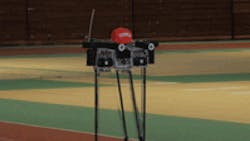Cornell's robot strolls 40.5 miles
On May 2, Cornell University's robot — Ranger — set a world record by walking 40.5 miles on a single battery charge without stopping or requiring human assistance. Ranger is a bipedal robot created in Cornell's Biorobotics and Locomotion lab, led by Andy Ruina, professor of mechanical and aerospace engineering. The robot began walking on Cornell's Barton Hall track on May 1 just after 2 p.m. and continued until May 2 at 9 p.m., after 30 hours, 49 minutes, and 2 seconds of uninterrupted walking. Ranger made 307.75 laps around the track (0.13 miles per lap) at a 1.3-mph gait.
Ranger's previous record was 14.3 miles, set last July. Before that, Boston Dynamics' BigDog, a four-legged, all-terrain robot, trotted 12.8 miles without refueling. The Cornell team's goal was to have the robot walk a full marathon (26.2 miles) without recharge, which Ranger did in just over 20 hours, and then it kept going. In contrast, at the world's first robot marathon held in Osaka, Japan, in February, robots were repeatedly recharged.
Ranger has six small onboard computers running about 10,000 lines of computer code. The programs run in a repeating loop every 1/500th of a second. The robot also has dozens of electrical and mechanical sensors.
The robot's total weight is 22 lb, of which six are lithium-ion batteries that power the electronics and motors. One motor extends the outer ankles, another extends the inner ankles, and a third swings the legs. A fourth smaller motor twists the inner legs for steering.
While most legged robots achieve stability by carefully controlling all joint angles, Ranger achieves its low energy use by letting the legs swing as they will, Ruina explains. What's more, most bipedal robots stand on flat feet. Ranger can't stand upright at all. Instead, it balances by falling and catching itself at just the right time with each step. For more information, visit cornell.edu.
